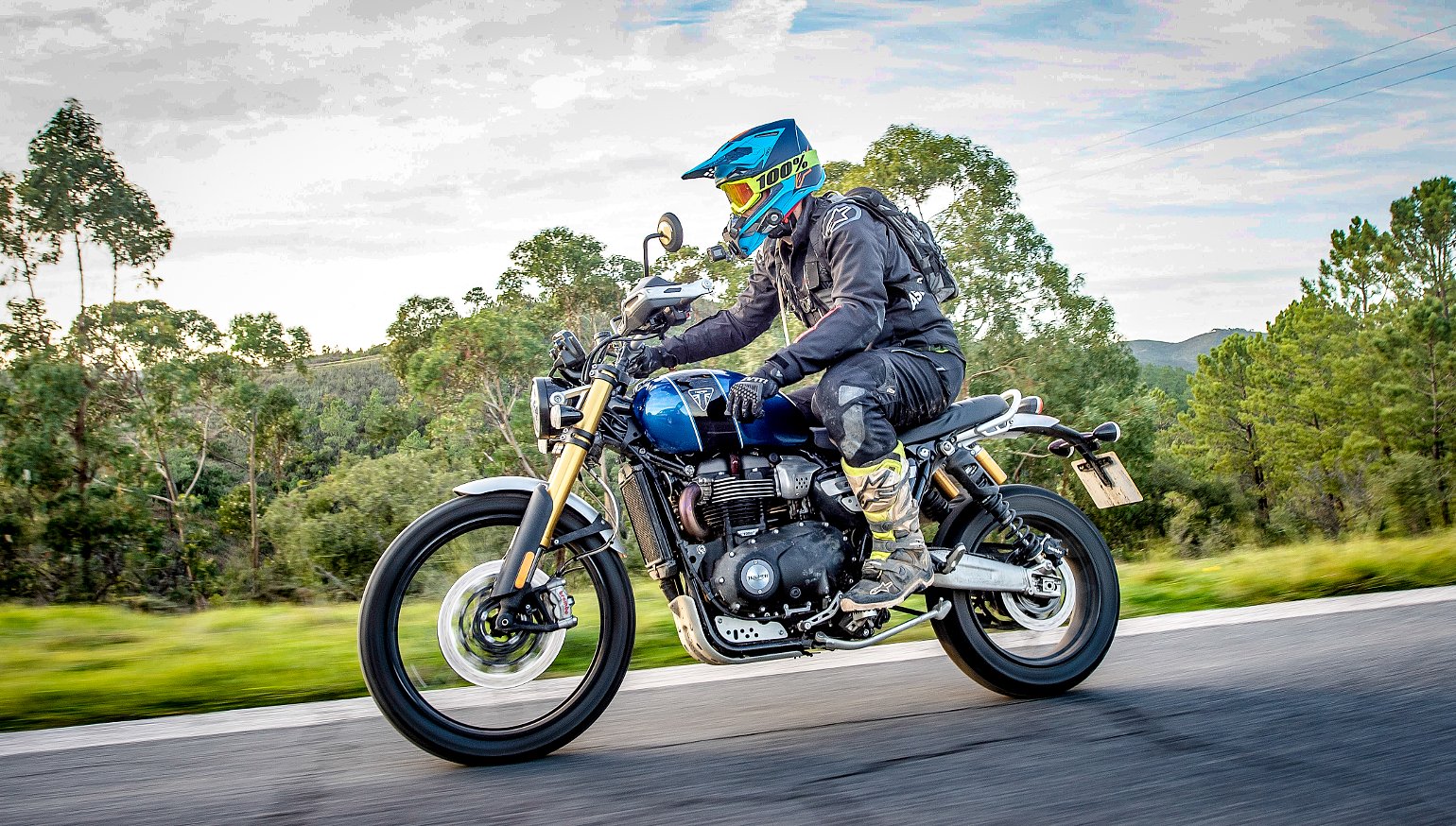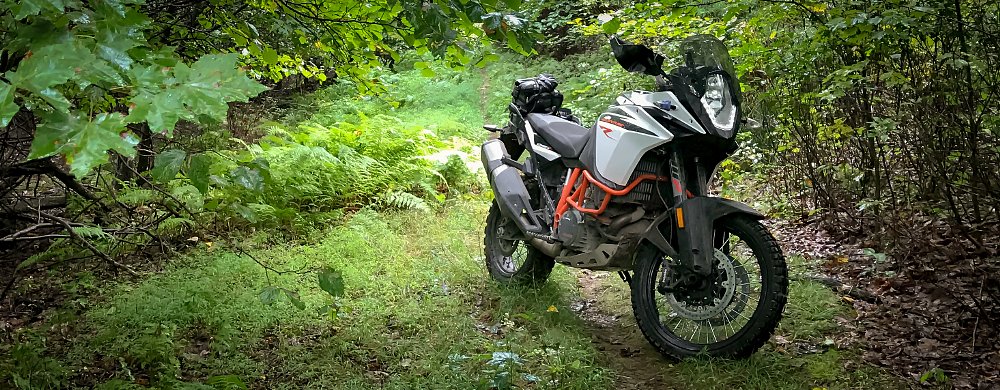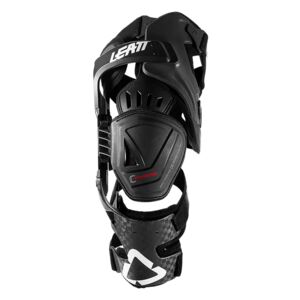It started with a hypothesis produced by Lemmy and Joe in their “Scramblers” video.
They concluded, based on the initial press release, that the new Triumph Scrambler 1200 is really a naked adventure bike. I found this to be an intriguing proposition. A retro-looking, naked bike, with all of the capabilities of an adventure bike. Intriguing, indeed.
When the invite came to ride the new Scrambler 1200 in Portugal, I threw my hat in the ring to head over and take it for a ride to test their hypothesis. After all, I’m nothing if not a champion for science. That and I’ve ridden nearly all of the current middleweight adventure bikes and I am the previous owner (and abuser) of a Tiger 800 XCx and the current owner of a KTM 1090 Adventure R.
As you read this review, keep in mind that the intention of an adventure bike is to be able to handle both street and off-road riding fairly well. There is usually a bit of a compromise on both ends to accommodate the duality of the machine. ADV bikes are usually flagship models for the OEMs, and as such, they usually spare minimal expense in bringing the newest technology and class-leading components to the table.
Let’s dive in.

The Triumph Scrambler 1200
The new Scrambler 1200 is available in two flavors, the XC and the XE. According to Triumph’s press team, the “E” in XE stands for “Extreme.” As in, it’s ready to tackle even more extreme off-road terrain than its sibling. What I’d like to do first is to present all of the facts that apply to both models and then explain the differences between both models, because it’s actually much more than just suspension travel, which seems to be the popular opinion on social media, at the moment.
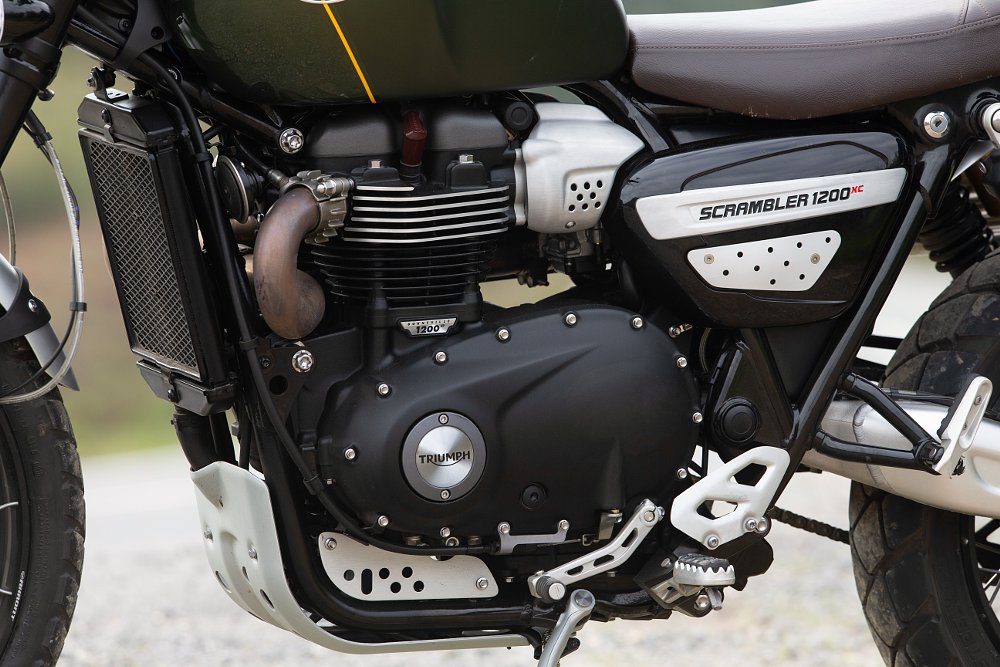
The heart of the new Scrambler is a revised and re-tuned version of Triumph's 1200 cc HP parallel-twin engine found in the Thruxton. The main changes come from a reduction of mass and reengineered inertia metrics on key internals, such as the balance shaft, alternator, and crankshaft. According to Triumph, no changes have been made to the camshafts. The bike also gets a dedicated ECU tune to reposition the power output slightly lower and spread it across the rev range.
I found it interesting that in the comparisons which they presented, Triumph focused on the T-120, which utilizes a different, HT (high torque) version of their 1200 cc p-twin. Essentially, the Scrambler’s engine sits somewhere between the T-120 and the Thruxton models. It claims 81 foot-pounds of torque at 3,950 rpm and 90 horsepower at 7,400 rpm.
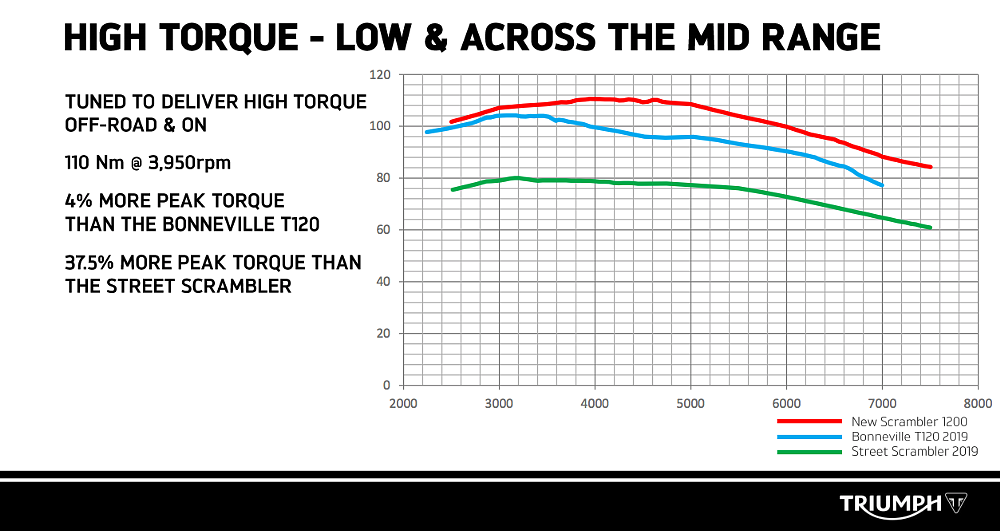
While this is technically less power than the Thruxton R, keep in mind that it is all about the distribution of power. The Scrambler’s peak torque is nearly identical to the Thruxton’s 82 foot-pounds, but hits 1,000 rpm lower in the rev range and looks like a damn torque plateau. This gives riders a lot of room for flexibility when it comes to gear selection. At the same time, the horsepower (down about eight ponies compared to the Thruxton) peaks 650 rpm higher in the rev range, thus broadening the overall powerband.
If you like revving the shit out of an engine to reach optimal power delivery, this bike is not for you. However, for folks who like to lug an engine and prefer an immediate boatload of torque at their fingertips, this motor will leave you with a grin.
Throttle response is drastically improved over both the T-120 and the Thruxton. I never liked the on/off throttle that I felt plagued both of those models. The new Scrambler 1200 has a damn near perfect throttle in all of the five (six on the XE) rider modes.
Each of the rider modes (Sport, Street, Rain, Off-Road, and Rider) alter the bike’s throttle response as well as the level of intervention from the ABS and traction control systems. The XE model also includes an Off-Road Pro mode, which allows the rider to completely disable ABS. On the XC version, ABS can only be turned off at the rear wheel. Both models receive electronic cruise control.
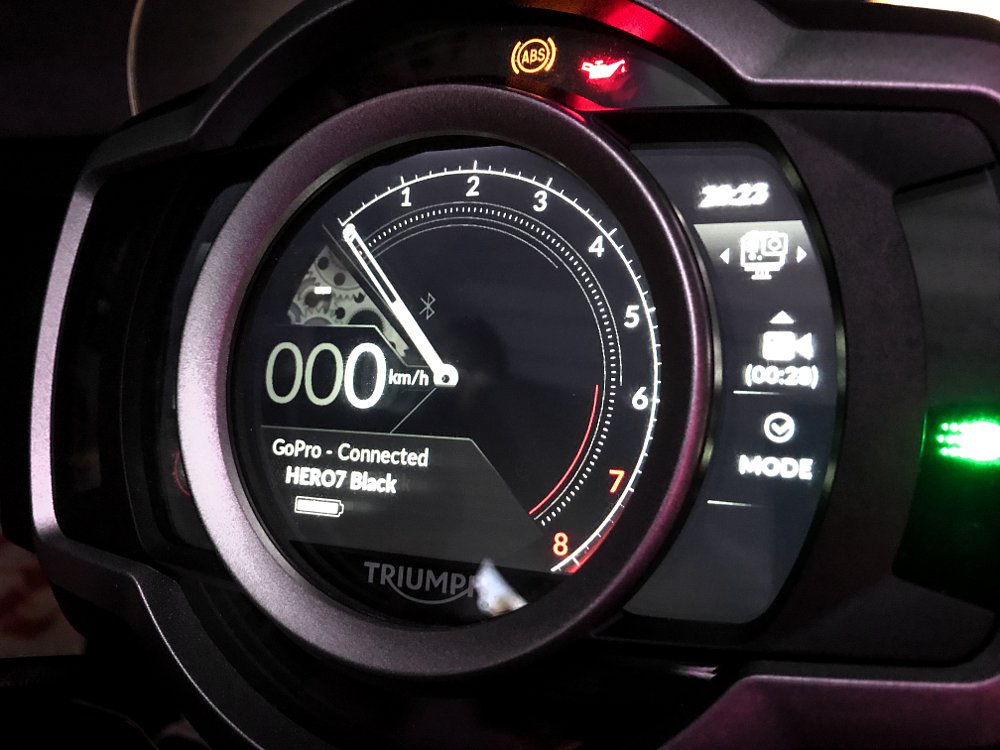
In addition to the standard electronics, Triumph has also introduced an app which will allow for turn-by-turn directions via Google Maps to be displayed on the newest TFT dash (a first for the brand). In addition, the Scrambler will be the first Triumph model (as well as the first bike from any OEM) that will allow for GoPro integration and control via the bike’s dash. We got to see the prototype of the technology on one of the models they had on display, but the final production version is still being finished so we weren’t able to test it on this ride (says the guy who was running three GoPros, trying to film a review while riding).
The GoPro technology doesn’t get me immediately excited as I am fine with just hitting the button on the camera, but it would be helpful when we have a camera positioned somewhere out of immediate reach. I am more interested in the turn-by-turn Google Map directions. I regularly navigate via my cell phone, so I see a lot of potential here. Regardless of how I feel, I think it’s cool that this was incorporated as a specific response to rider feedback collected by Triumph. They seem to be listening to what their customers are asking for. Hence, the Scrambler 1200 gets removable passenger foot pegs. Still waiting for that on the Tiger 800…
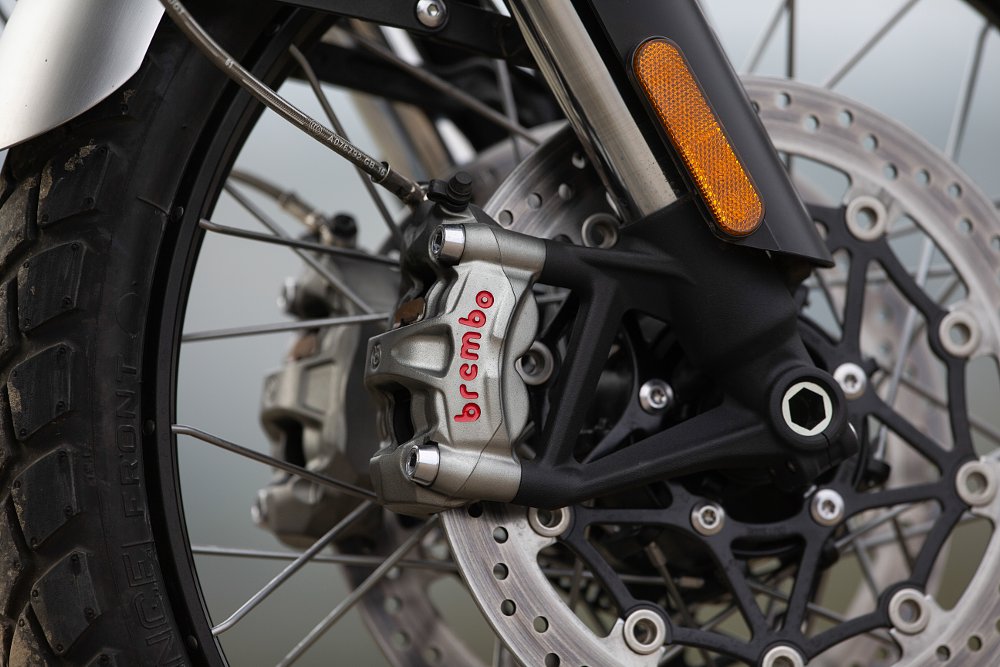
Braking duty on the Scrambler 1200 is handled by two massive Brembo M50 four-piston radial monoblock calipers up front and a two-piston Brembo floating caliper at the rear. Fluid is fed from the master cylinders to the calipers via steel braided lines. These are the same brakes I gushed over on the Street Triple RS. The XE version even gets the same MCS levers. Just amazing, top-of-the-line, stopping power.
Forgoing the WP setup found on their Tiger 800s, both bikes utilize a fully adjustable Showa inverted fork. Compression and rebound duties are split between the two fork legs and both receive adjustment for preload, a feature not found on the Tiger 800’s front end.
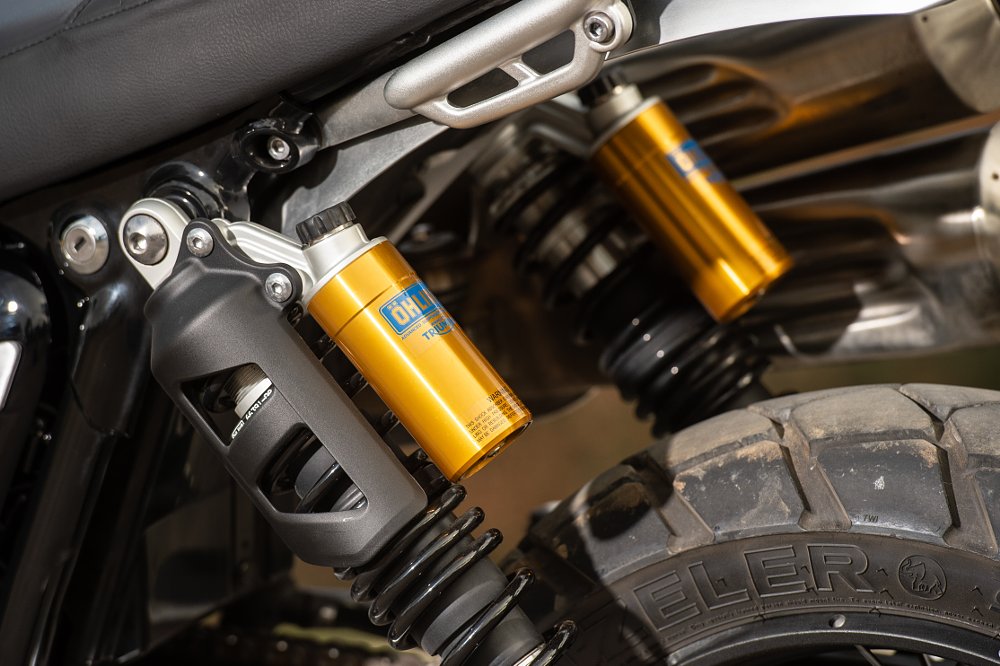
Suspension duties at the rear of the bike are handled by two of the biggest Ohlins piggyback shocks I’ve ever seen. Custom made for these Scrambler models, the pair on the XE feature an additional two inches of travel and are nearly as long as my arm. The shocks are fully adjustable with a preload collar and two clickers on each shock for compression and rebound damping.
The suspension connects the all-new frame to the cross-spoked, tubeless rims. The Scrambler’s front wheel utilizes a 90/90-21 tire and the rear is a 150/70R17. There were a few of us chatting about the fact that we wished they had gone with an 18-inch rear for a better selection of off-road rubber, but the Pirelli Rally Scorpion tires we used off-road were extremely impressive. It was my first time using these tires and I really liked them. I know my buddy Steve Kamrad has been using them on his current Tiger 800 XCa and has been singing their praises.
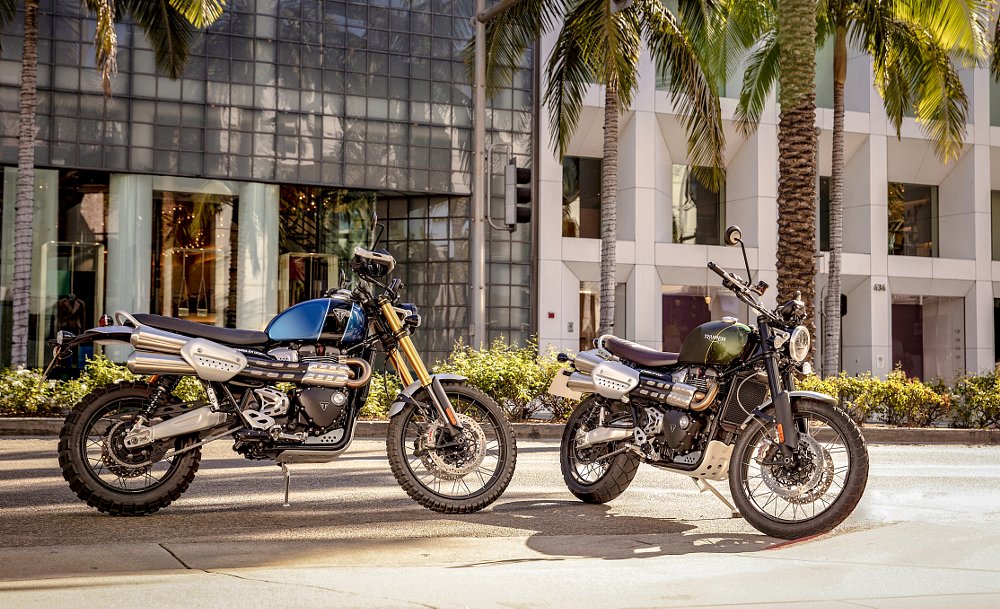
XC vs XE
One of the first comments I saw roll through on Instagram over the weekend was from a rider asking if the upgrade to the XE for the extra suspension travel was worth the additional money. I think this speaks to one of the biggest issues I have with the way Triumph markets their bikes. They do a great job building a quality product and differentiating their lineup, but they falter when it comes to explaining how their models are different and why you would want to choose one over the other.
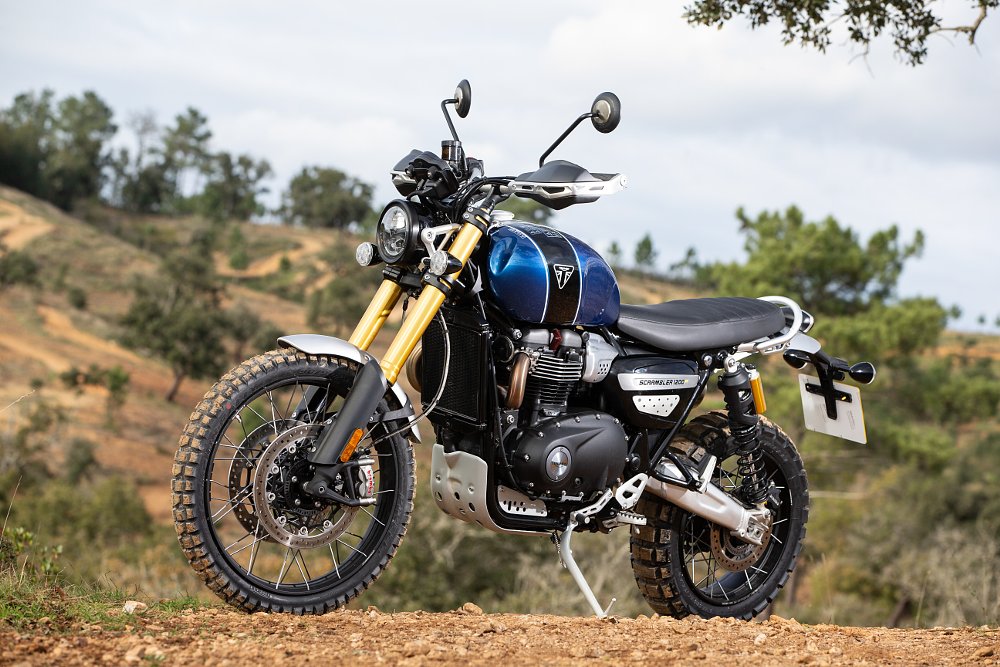
To be clear, the differences between the XC and the XE go far beyond suspension travel, but we might as well start there. While both bikes get the same high-end suspension components, the XE utilizes 47 mm fork tubes with nearly two additional inches of travel in the fork as well as the rear shocks. Compared to the 45 mm fork with 7.9 inches of travel on the XC, the XE gets a whopping 9.8 inches. That beats nearly every mid-sized adventure bike on the market (the Africa Twin L2 has 9.9 inches of travel out of its 45 mm fork).
The additional travel also means a higher seat height of 34.25 inches, a little over an inch taller than the 33.1-inch seat height on the XC. While shorter riders might struggle with the taller option, the XE provides better ground clearance for gnarly terrain off-road. There will be a low-seat option for both bikes that will reduce seat height by about an inch.
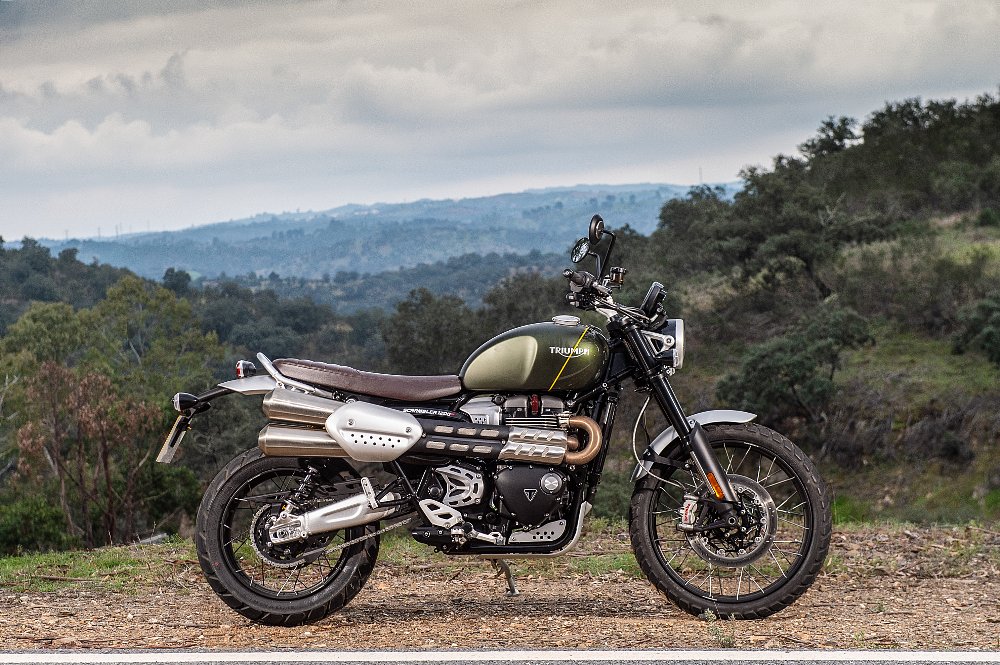
In addition to the longer travel suspension, the XE’s overall geometry is completely different. It gets a longer swingarm and increased rake and trail. This means a longer wheelbase for better stability off-road. It also gets a wider handlebar with a removable 10 mm riser included for an improved reach to the bar while standing. At six feet, three inches, I had no problem reaching the grips in a standing position.
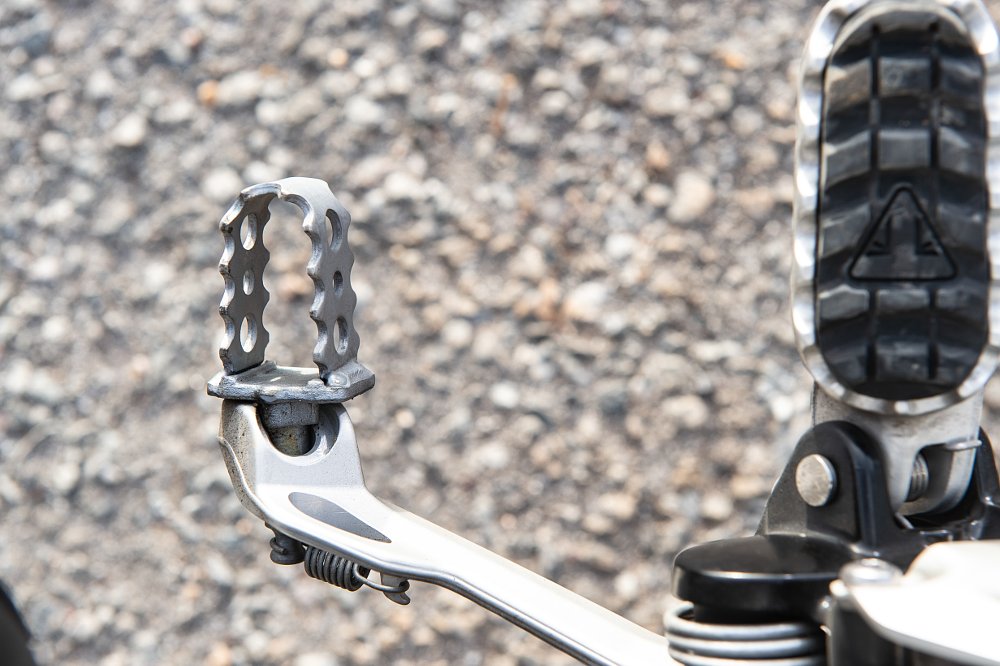
While both bikes feature a folding brake pedal, the XE’s pedal can quickly be adjusted for a better reach to the rear brake while standing. The handlebar controls are different as well. As I mentioned earlier, the XE gets the upgraded MCS levers which allow for a maximum amount of adjustability for both the throw of the lever as well as allowing the rider to alter the progressive feel of the front brake. That being said, I was impressed with the quality and adjustability of the base levers on the XC. The XE gets aluminum-backed handguards to protect those fancy levers, something I’ve yet to see as a stock option on any current adventure bike.
From an electronics perspective, the XE gets that additional rider mode, Off-Road Pro, which allows the rider to easily and completely shut off traction control and ABS. On the flip side, it receives an IMU, which means lean angle is taken into consideration when ABS and TC are engaged in Sport, Street, or Rain mode (it’s not active in either of the off-road modes). Heated grips are also standard on the XE version.

You’ll also notice that styling is slightly different between the two models. While I liked the half-matte, half-gloss green on the XC, the matte shows marks way too easily to push hard off-road, unless you like the abused look.
Hopefully this helps you better understand the “how” when it comes to differentiating between the details of these models. To figure out the “why” for choosing one over the other, we must first ride them.

Scrambling off-road
We kicked off our time in Portugal at Wims Motor Academy, an off-road training facility about two and a half hours south of Lisbon. Triumph turned us loose on a flat-track course, a motocross track, an enduro course, and two separate hour-long off-road loops. To say that they were confident in the Scrambler’s off-road ability is a bit of an understatement.
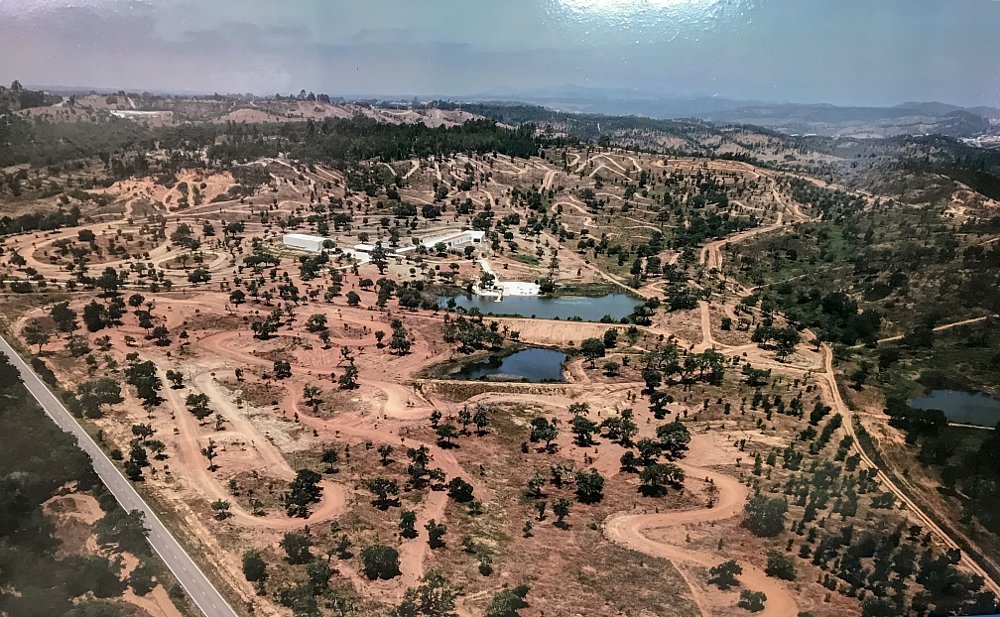
It had rained earlier in the week and the ground was wet and tacky. We each started off with loops around the flat track to get a feel for the bike. I was on an XE and I was impressed with how stable the bike felt underneath me. I am not a regular on the dirt oval like Lem is, but I found it was a good way to loosen up and get a feel for the bike before heading out on one of the off-road loops.
The off-road tracks were essentially two-lane trails with mud, sand, and gravel all thrown into the mix at different times. The XE tracked perfectly through all of it. There were times I felt sure the bike was going to go loose under me, but it never did, even in the mud and sand. It was much more stable than I remember my Tiger 800 XCx being in similar terrain. Very impressive.
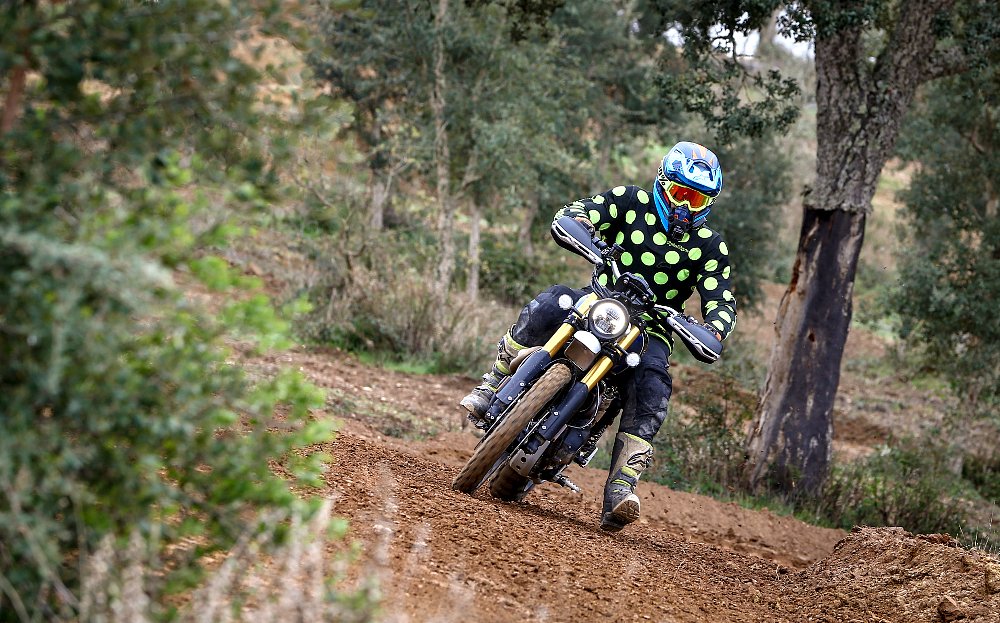
As I’m used to having to spin the power out of my 1090, it took a little getting used to all of the torque hitting right away. There were a couple of moments where I was spinning sideways out of a corner, but the bike never felt out of control.
Normally on my ADV bikes I turn the traction control completely off and leave the ABS on at the front wheel but off on the back. However, the off-road traction control on these new Scramblers is so good, I never found the need to turn it off completely. I rode in standard off-road mode (which is available on both models) and never felt like the system was interfering with my riding like it does on my KTM or my old Tiger.
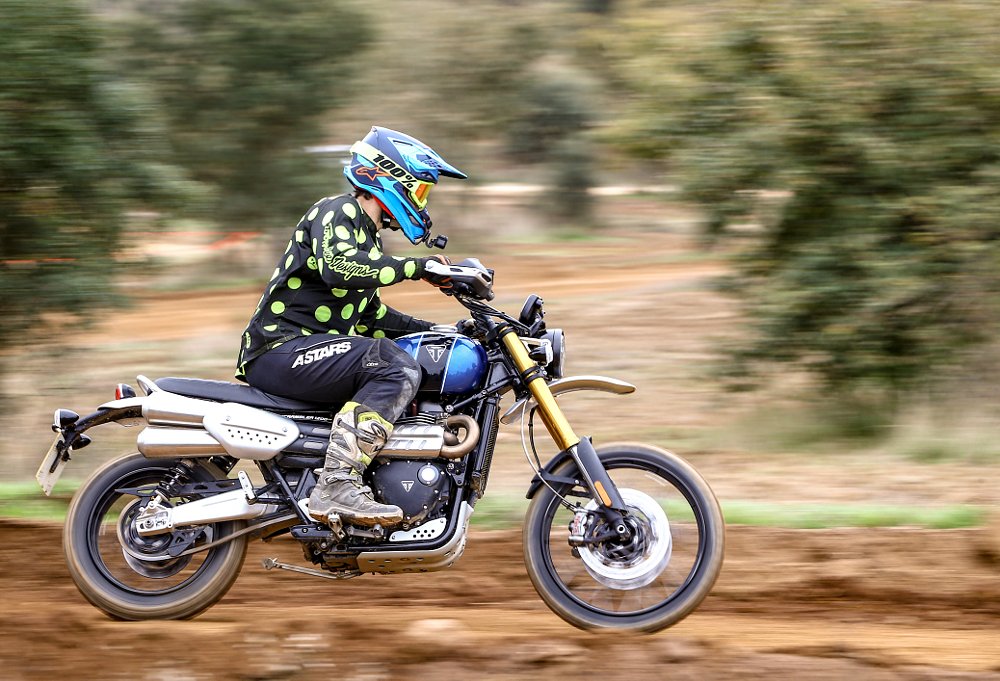
According to Stuart Wood, the chief engineer on the project, the off-road TC allows for 50 percent rear wheel slip before kicking in. Not so different from other TC systems, right? Well, in addition, the system can sense if you’re increasing throttle input, so it automatically adjusts for increased wheel slip which stops the system from interfering when you don’t want it to. It works perfectly, even when jumping the bike.
I know that because I spent the afternoon turning laps on the motocross track. Jumping a series of little four-foot kickers was the only time I was able to reach the limits of the XE’s suspension stroke. The front would make a loud thump but then immediately stabilize. Extremely damn impressive considering this bike has to weigh about 500 pounds with fluids added and I weigh at least 240 pounds with all of my moto gear on.
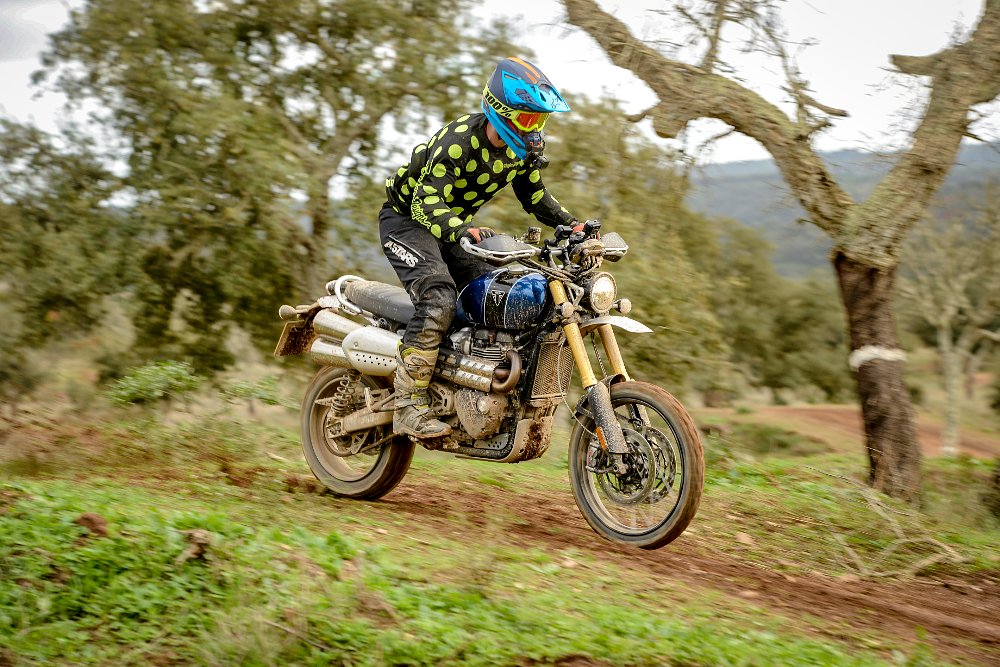
That being said, it’s still a big bike. It requires a lot of wrestling and body English to get the bike through tighter corners. But it’s extremely easy to transition between standing up and sitting down. Even the dash can be tilted to meet the rider’s line of sight regardless of body position.
The one thing to note is that the Scrambler does feel wide. Between the high-mount exhaust on the right side, and the side pod on the left side, you feel like your legs are spread pretty far apart. Heat could be felt radiating off the exhaust when stopped, but it didn’t bother me much when riding. No more than I notice at my right foot on my 1090.
If you remember back to the F 850 GS review, one of my biggest complaints was the fact that it was extremely hard to ride standing up because I couldn’t get my feet on the controls while wearing motocross boots. The Scrambler did just fine, even in stock form without any adjustments.
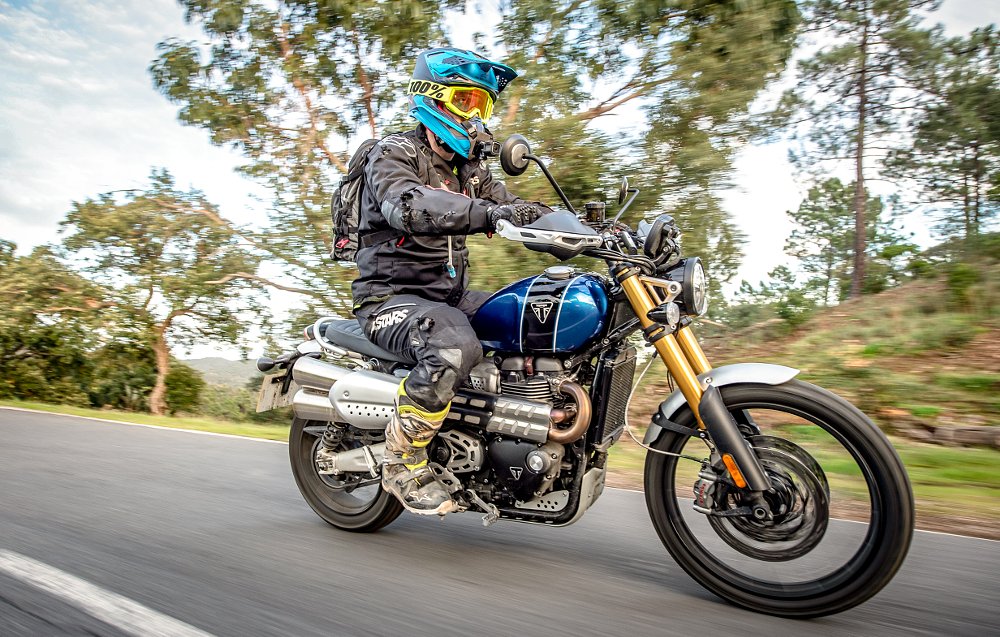
Street scrambling
We exited our hotel on the second day to find a slow but steady rain soaking us, the bikes, and the asphalt. We were broken up into groups of six and assigned a ride leader. Ours was a fellow by the name of Joe with a history of road racing. He gathered us around and warned us that the roads we would be on were going to be particularly slick in the rain. He made sure to look us each in the eye as if to drive home his point.
Less than 15 minutes later, I found myself sliding across two lanes of traffic with my right leg (the same one I fractured at the Himalayan launch earlier this year) trapped under the bike.
There had been no warning, I hadn’t touched the brakes or throttle. We were all traveling slowly. I was simply rolling through the corner at about 25 mph when the front end completely washed out as if I’d hit ice. There are some crashes that even ABS and sophisticated traction control can’t prevent.

Luckily, I was wearing my off-road gear and my Leatt C-frame knee brace and Alpinestars Bionic Action armor took the brunt of the abuse. My knee brace literally saved my leg and the bike, acting as a slider between the bike and the asphalt. The bike suffered a bent brake lever, a scratched bar end, and a loose exhaust shield and I didn’t have a scratch on me. We were lucky there wasn’t any oncoming traffic, otherwise things could have ended differently.
The bike fired up without even a slight hesitation and we continued on, albeit a bit more cautiously than before.
The Scrambler’s glaring difference from the rest of the ADV crowd became immediately transparent in the first half of the day. There was absolutely no protection from the elements. If I was going to tackle longer distances on the highway with the Scrambler I would opt for adding a clip-on windscreen. Much like I used to do when I was making cross country treks with my old Bonneville.
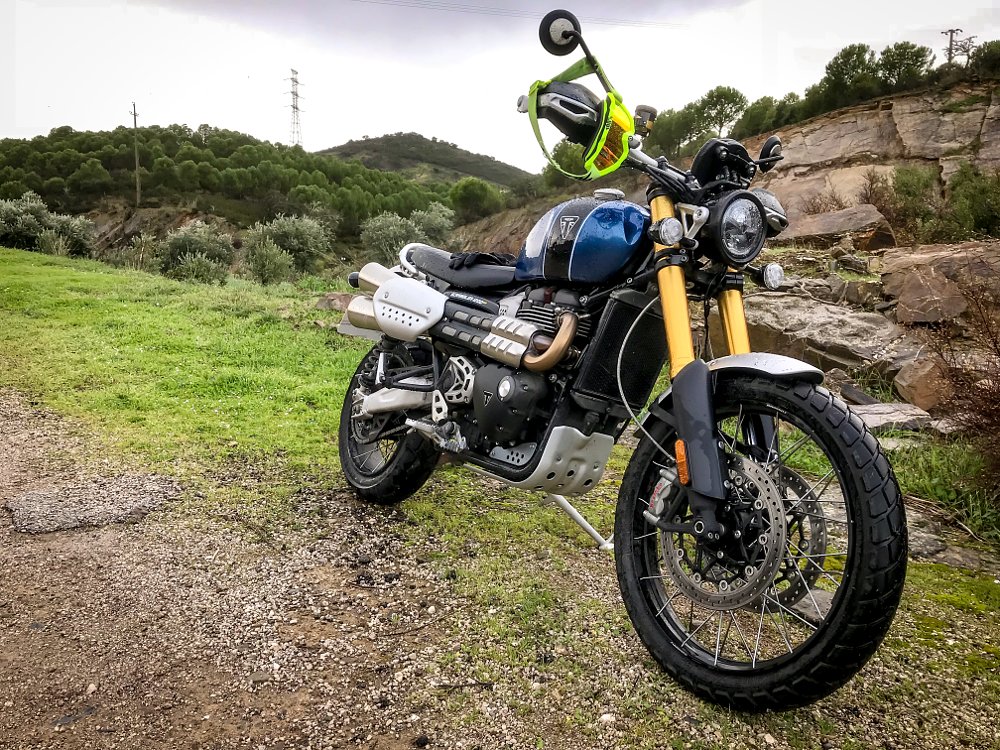
We took turns swapping between XC and XE models to get a feel for both. More than once I saw the little TC warning light illuminate as I cranked back on the throttle. It was the first time on a press ride where I had multiple opportunities to test both ABS and traction control so regularly. I was really impressed with Triumph’s rider modes on this bike. I never really felt they did much on my old Tiger, but on this bike, there were distinct differences between the modes.
I do wish that both bikes would have received the IMU, especially because the XC is the more “street friendly” version and it isn’t actively intervening in either of the off-road modes anyway. Although I am sure they had to cut cost somewhere.
As the day rolled on the rain stopped and the sun quickly dried out the roads. During the second half of the day the pace increased, and we got a chance to push the bikes on some very sporty roads.
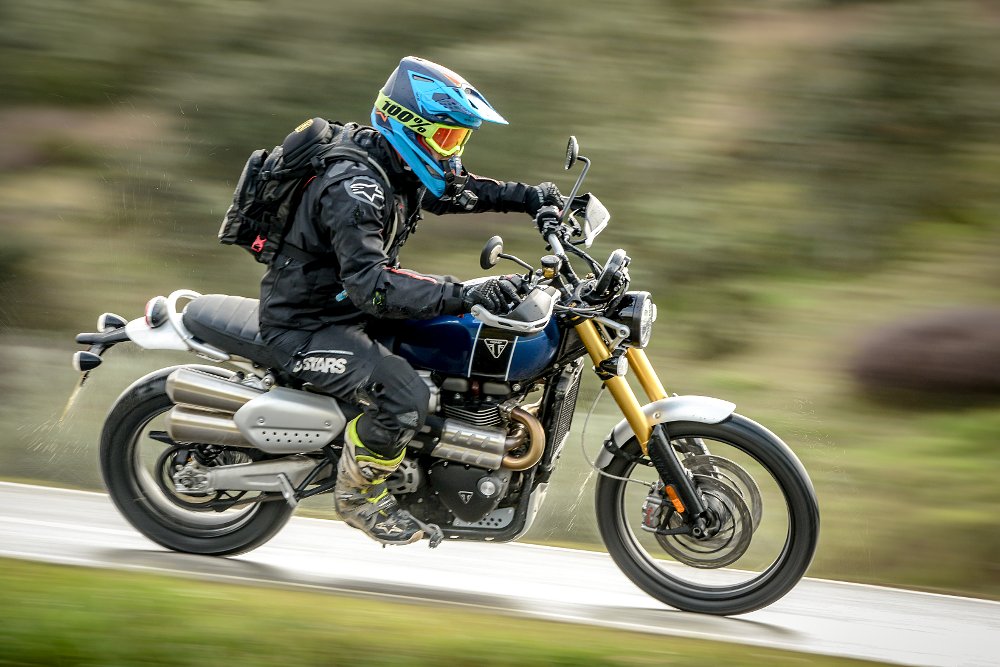
While the XC did handle the corners marginally better than the XE, neither one was particularly “flickable.” You really have to work the bike to get it through the corners. I think the wider handlebar of the XE helped it to overcome some of its geometric disadvantages. All things considered, I had a blast with both bikes. They were extremely fun, and even without a windscreen, I could easily ride one of these for a 300-mile day in stock trim without a complaint.
We tackled roughly 140 miles before the fuel light came on, letting us know there was about a gallon of gas left. I would expect that if I were to perform some more accurate tests I would have averaged somewhere between 40 to 45 miles per gallon. That gives the bike a range of somewhere between 160 to 180 miles per tank.
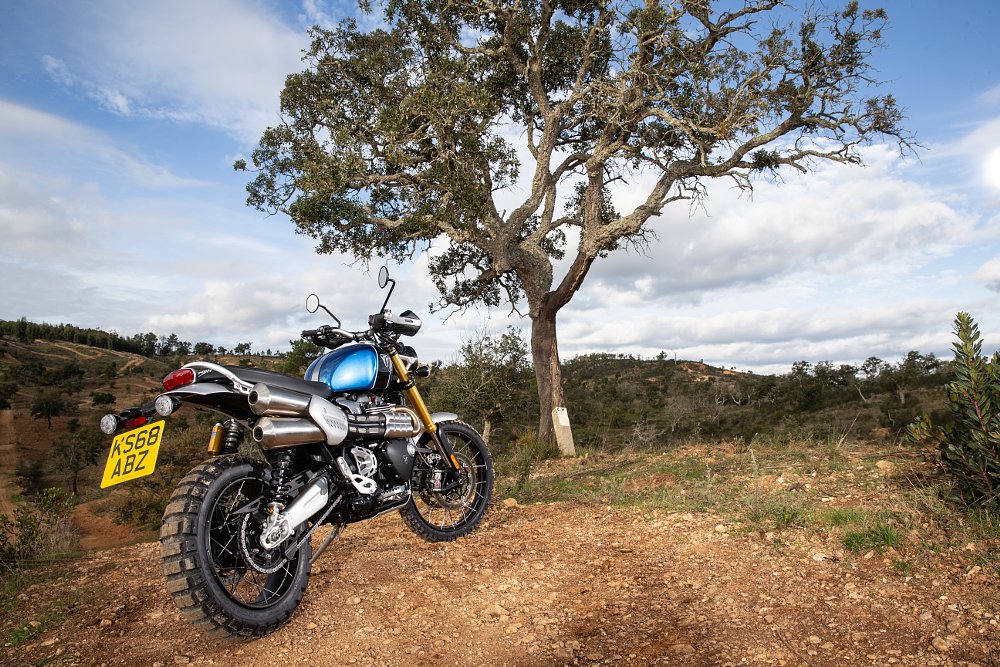
Competition
The MSRP of the Scrambler 1200 XC is $14,000 and the Scrambler XE is $15,400. There has been a lot of grumbling on the internet regarding the price of this bike. But really, when you consider everything Triumph included on this model, I think it’s a fair price that’s right in line with the rest of the ADV segment. And considering the price, I held it to the same level of accountability I would any other premium bike in this class.
I had the following four bikes in mind when rolling through the hills of Portugal: Triumph’s Tiger 800 XCx, BMW’s F 850 GS, KTM’s 1090 Adventure R, and Honda’s Africa Twin (not the Adventure Sports model as I’ve yet to ride that bike). My goal as I thought about Lemmy and Joe’s claim was to determine whether the Triumph Scrambler 1200 could hang with these bikes. And the answer would unequivocally be yes.
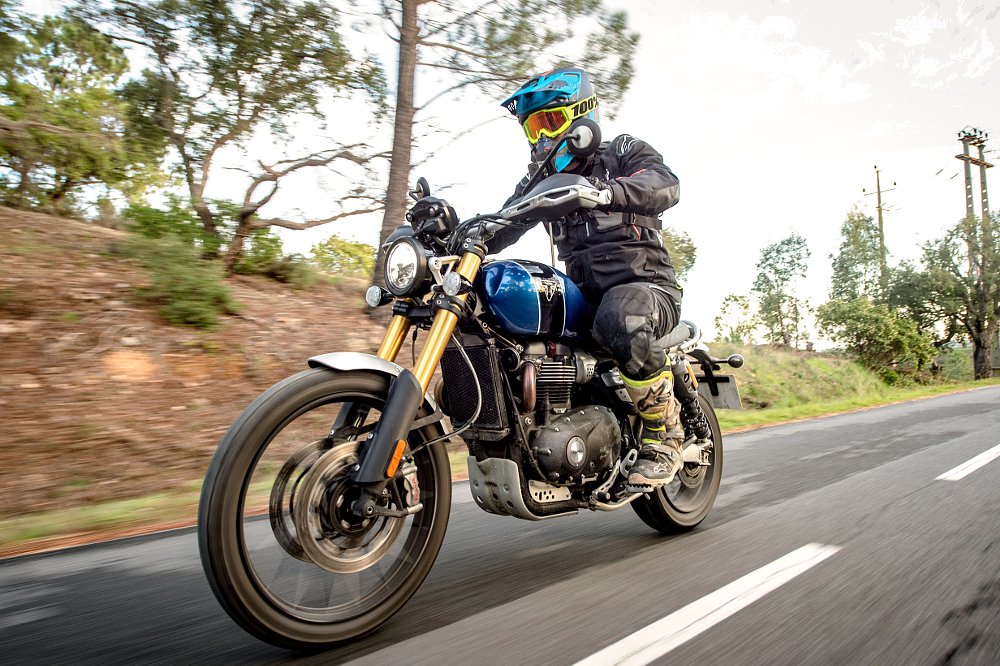
Its engine makes more torque than all of those bikes except the 1090. The 1090 is also the only one that comes close to equaling the Triumph's suspension. The Triumph has better brakes than any of those four bikes. It’s got true cross-spoked wheels that don’t require tubes, something only the F 850 GS among those four matches. Its electronics package bests the 1090 and Africa Twin and is on par with the other two. It’s around the same weight, if not lighter, than all of these bikes, and it has a styling completely unique to itself.
The styling is where the “naked” adventure bike part of the boy’s theory comes into play. There is no protection from the elements aside from some handguards and heated grips, finding luggage to easily work with this bike is going to be tricky, and passenger accommodations are minimal. But the style is also what makes this bike look so different, in such a good way.
The final question is the why. Why do you go with the XE over the XC? Personally, the bump to XE is a no-brainer for me. It’s better for riding aggressively off-road and with the added height it feels slightly “bigger,” which I like. I’m a big guy. But the XC is a really great bike in its own right and it handles itself slightly better on the road. If you’re interested in tackling a dirt trail or an adventure ride with your buddies, the XC will handle the task with ease. If you try jumping across a motocross track or slagging it over a rock garden or through deep mud than you might find the XC a bit… limiting.
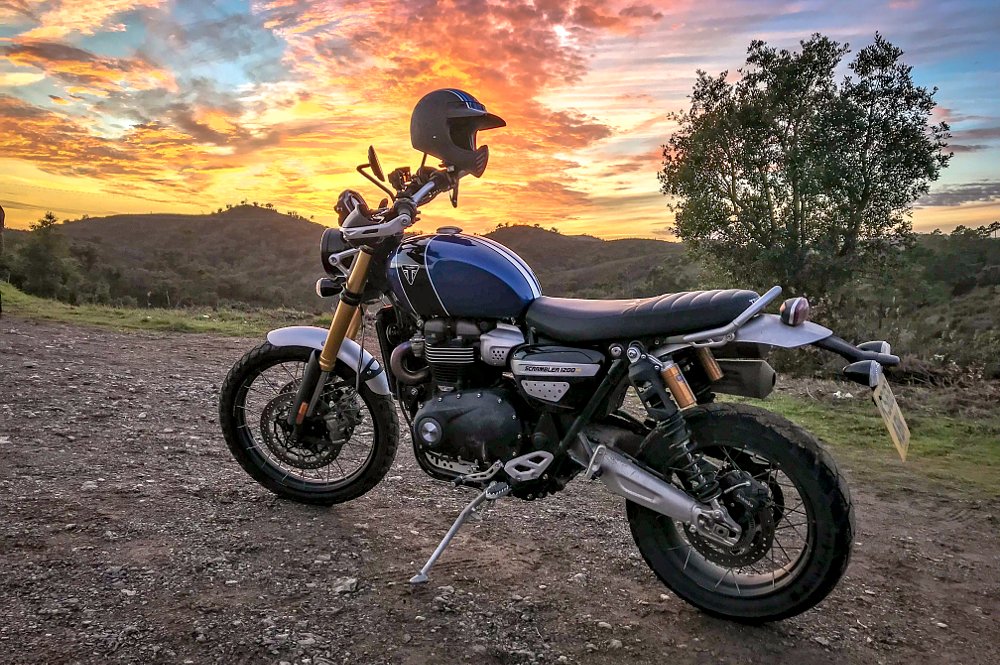
Conclusion
I went into this review searching for something not to like. Trying to find things to pull apart. The front brake lines stick out in the wind and could possibly get snagged off-road, the accessory high fender kit lets too much mud accumulate on the radiator, which can cause the bike to overheat, and the body is a bit wide. If anything, I think it looks too nice. I am going to have a hard time wanting to crash this bike off-road. You’re going to have to invest in a set of crash bars. But really, I struggled to come up with points where Triumph missed the mark.
If you don’t personally like the style, I can understand that. But Triumph made sure there is no way critics will be able to put this bike down based on its merit.
After two days of testing, I can tell you that the boys’ hypothesis appears to have been proved correct. This lives up to all the expectations I would have for any adventure bike out there, sans the body work. Hence, a naked adventure bike. But if Triumph wanted to send us one in the spring for further testing, I wouldn’t be opposed to riding one of those blue XEs around a little bit more. You know, for science.
| 2019 Triumph Scrambler 1200 XC and XE | |
|---|---|
| Price (MSRP) |
$14,000 (XC) $15,400 (XE) |
| Engine type | Liquid-cooled, SOHC, four valves per cylinder, 270-degree crank angle parallel twin |
| Displacement | 1200 cc |
| Bore x stroke | 97.6 mm x 80 mm |
| Compression | 11.0:1 |
| Power (claimed) | 90 horsepower @ 7,400 rpm |
| Torque (claimed) | 81 foot-pounds @ 3,950 rpm |
| Transmission | Six-speed |
| Front suspension |
Fully adjustable 45 mm Showa USD cartridge fork (XC) Fully adjustable 47 mm Showa USD cartridge fork (XE) |
| Rear suspension | Fully adjustable Öhlins piggyback RSU's with twin springs |
| Suspension travel front/rear |
7.9 inches / 7.9 inches (XC) 9.8 inches / 9.8 inches (XE) |
| Front brake | Twin 320mm discs, Brembo M50 monoblock calipers, radial master cylinder |
| Rear brake | Single 255mm disc, Brembo two-piston floating caliper |
| Tires front/rear |
90/90-21; 150/70R17 Metzeler Tourance Tires (as tested on street) Pirelli Scorpion Rally tires (as tested off-road) |
| Rake |
25.8 degrees (XC) 26.9 degrees (XE) |
| Trail |
4.76 inches (XC) 5.09 inches (XE) |
| Wheelbase |
60.24 inches (XC) 61.81 inches (XE) |
| Seat height |
33.1 inches (XC) 34.25 inches (XE) |
| Tank capacity | 4.2 gallons |
| Dry weight (claimed) |
452 pounds (XC) 456 pounds (XE) |




